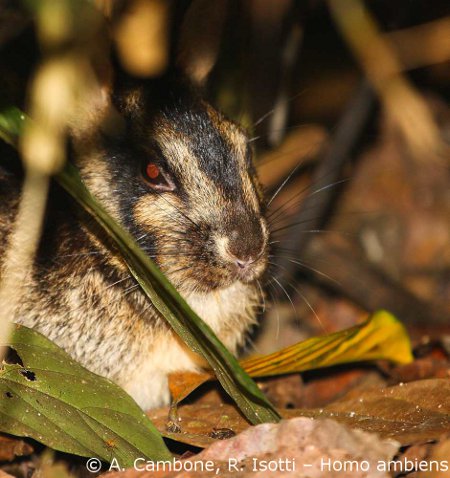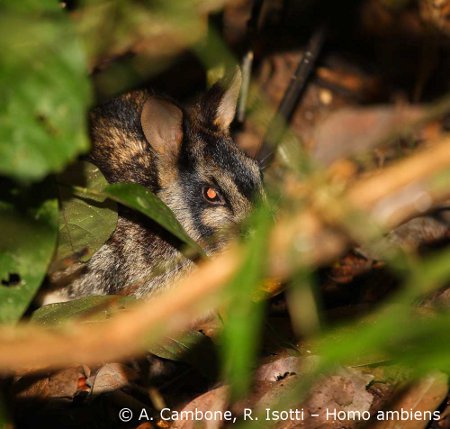
The distinctive brown stripes on the face and body of the Sumatran rabbit (Nesolagus netscheri) enable it to blend perfectly with its rainforest habitat. In 2008, WWF scientists stumbled upon a single rabbit, but it had not previously been seen since the 1930s. Today it is still considered the rarest and most elusive rabbit in the world.
From the Leporidae family, the Sumatran rabbit was believed to be the only species in the Nesolagus genus until the mid 1990s when a similar striped rabbit (N. timinsi) was discovered in the rainforests along the Annamite Mountains between Laos and Vietnam. Genetic studies suggest that the two species probably diverged about eight million years ago.
Roughly the same size as a European rabbit, the Sumatran rabbit has distinctive brown stripes running down the face and body, with tiny ears and a short tail. There is very little information on the ecology of this species, as it has never been studied in the wild. Sumatran rabbits are shy and only feed at night, their diet consisting of leaves and stalks. The rabbits have been recorded in dense montane forests on rich volcanic soil in southwest Sumatra, usually at altitudes of 600-1600 metres above sea level. Their habitat lies within the Sundaland Biodiversity Hotspot, which is home to at least 13 Critically Endangered species.

Surveys were carried out in 1983, 1984 and 1989, all of which failed to find any direct evidence of the species. Local people do not have a name for it in their own language, and many do not even realise that it exists. The Sumatran rabbit’s biggest threat, as with so many other tropical species, is conversion of its forest habitat into plantations.
A live rabbit was captured on camera in 2007, and there were sightings of rabbits in 2011 in two different national parks, again via a camera trap. WWF scientists who explored Bukit Barisan Seletan National Park in September 2008 were lucky enough to happen upon one of the rabbits and was able to take a direct photo of it. Most recently in May this year, a research group from the University of Delaware who had travelled to Sumatra looking for leopard, instead found images of a Sumatran striped rabbit on their cameras in Bukit Barisan Seletan. They believe that this remote area has not been subject to much pressure from poachers which is why the rabbit has been seen. They also found that scientists in Kerinci Seblat, the largest national park in Sumatra, had recently seen the rabbits multiple times. Now the group aims to establish an in-depth study of the area to shed more light on the ecology of the rabbits.
Relevant links:
- First view article of the research group’s paper in Oryx
- See the camera trap footage of the Sumatran rabbit
- The latest EDGE news
EDGE is working to increase conservation capacity in many different countries all over the world, and right now we are trying to save the last 100 pygmy sloths from extinction…
